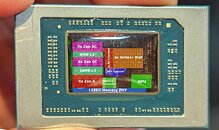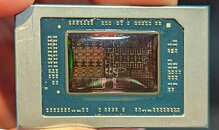- Joined
- Oct 9, 2007
- Messages
- 47,670 (7.43/day)
- Location
- Dublin, Ireland
| System Name | RBMK-1000 |
|---|---|
| Processor | AMD Ryzen 7 5700G |
| Motherboard | Gigabyte B550 AORUS Elite V2 |
| Cooling | DeepCool Gammax L240 V2 |
| Memory | 2x 16GB DDR4-3200 |
| Video Card(s) | Galax RTX 4070 Ti EX |
| Storage | Samsung 990 1TB |
| Display(s) | BenQ 1440p 60 Hz 27-inch |
| Case | Corsair Carbide 100R |
| Audio Device(s) | ASUS SupremeFX S1220A |
| Power Supply | Cooler Master MWE Gold 650W |
| Mouse | ASUS ROG Strix Impact |
| Keyboard | Gamdias Hermes E2 |
| Software | Windows 11 Pro |
AMD on Monday launched its Ryzen AI 300 line of mobile processors based on the 4 nm "Strix Point" monolithic silicon. This chip was described by AMD as having a maximum CPU core configuration of 12-core/24-thread, which would be a neat 50% increase in core-counts over the previous generation; but there's more to it. Although "Strix Point" implements "Zen 5," not all 12 CPU cores on the silicon are the regular variant of "Zen 5." The chip physically has four "Zen 5" cores, and eight "Zen 5c" compact cores. Nemez (GPUsAreMagic) attempted to annotate the "Strix Point" die based a high-resolution photo by System360Cheese from AMD's Computex keynote; and there are some interesting findings.
The annotation reveals that the four regular "Zen 5" cores, each with a 1 MB dedicated L2 cache, share a 16 MB L3 cache. The eight "Zen 5c" cores, on the other hand, appear to share a smaller 8 MB L3 cache, in what could be a separate CCX. They each have a 1 MB L2 cache, too. The "Zen 5c" cores have the same IPC as the "Zen 5" cores when measured with common INT and FP benchmarks that don't move a lot of data; however, it could lag behind in workloads with a lot of streaming data. What's more, the previous generation "Zen 4c" cores were traditionally limited to lower frequencies than regular "Zen 4" cores, as the physically compacted cores couldn't hold onto higher core voltages. If that's the case with "Zen 5c," then what we're really looking at with "Strix Point" is an interesting hybrid core setup with eight high-IPC efficiency cores.


View at TechPowerUp Main Site | Source
The annotation reveals that the four regular "Zen 5" cores, each with a 1 MB dedicated L2 cache, share a 16 MB L3 cache. The eight "Zen 5c" cores, on the other hand, appear to share a smaller 8 MB L3 cache, in what could be a separate CCX. They each have a 1 MB L2 cache, too. The "Zen 5c" cores have the same IPC as the "Zen 5" cores when measured with common INT and FP benchmarks that don't move a lot of data; however, it could lag behind in workloads with a lot of streaming data. What's more, the previous generation "Zen 4c" cores were traditionally limited to lower frequencies than regular "Zen 4" cores, as the physically compacted cores couldn't hold onto higher core voltages. If that's the case with "Zen 5c," then what we're really looking at with "Strix Point" is an interesting hybrid core setup with eight high-IPC efficiency cores.


View at TechPowerUp Main Site | Source




